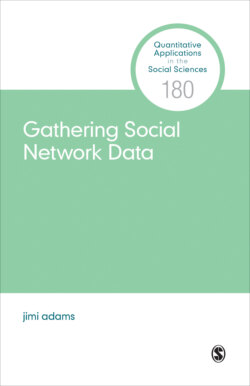Gathering Social Network Data

Реклама. ООО «ЛитРес», ИНН: 7719571260.
Оглавление
jimi adams. Gathering Social Network Data
Quantitative Applications in the Social Sciences
GATHERING SOCIAL NETWORK DATA
CONTENTS
Series Editor’s Introduction
Preface
A Brief Note on Reading This Book
Acknowledgments
About the Author
Chapter 1. Why Focus on Relationships?
Motivating Network Research
Description, Network Theories, and Theories of Networks
Two Broad Theoretical Frameworks
Longitudinal Networks
Types of Ties
Outline of the Book
Chapter 2. Sampling and Measuring Network Ties
Network Measurement
Name Generators
Name Interpreters
Position and Resource Generators
Sampling Designs
Ego Network Designs
Complete Network Designs
Source(s) of Information
How Complete Is Complete?
Partial Network Designs
Respondent-Driven Sampling
Node Matching
The “Boundary Specification Problem”
A Note on Nonsurvey Methods
Chapter 3. Modes of Network Data Collection
Active Research Participants
Interview Methods
Survey Methods
Incorporating Technological Advances Into the Survey Experience
Apps and Online Platforms
Triangulating Social Network Data and Comparing Modalities
Passive Data Collection
Systematic Social Observational Tools
Digital Trace Data
Application Programming Interfaces (APIs)
Network Experiments
“Complex” Network Data
Bipartite and Multi-mode Networks
Temporal Networks
Multiplex Networks
Cognitive Social Structures (CSS)
Chapter 4. Ethical Considerations
Voluntary Participation and Informed Consent
Are Alters Human Subjects?
Obtaining Consent
Balancing Risks and Benefits
Deductive Disclosure and Deanonymization
Protections From Risks
Using and Presenting Network Data “Dark” Network Data
Presentation of Results
A Shared Code of Ethics
Chapter 5. Data Quality: Assessment, Implications, And Improvements
Missing Data
What Data Are Likely to Be Missing?
Imputing and Modeling Missing Data
Data Reliability and Validity
Descriptive Data Quality
Respondent and Interviewer Effects
Interpreting the Meaning of Relational Data
Comparing Dyadic Reports
Comparing Multiple Reports of the Same Ties
Comparing to External Data Sources
Analytic Data Quality Implications and Solutions
Robustness of Network Centrality and Other Measures
How Data Quality Shapes Analytic Interpretations
Incorporating Data Uncertainty Into Network Models
Chapter 6. The Way Forward
Appendix A
Glossary
Recommended Additional Resources. General Social Science Data Collection
Overview Summaries of SNA
In-Depth Treatments of SNA
Appendix B: Network Data Formats
Appendix C: Existing Data. Sample Instruments
Social Survey of the Networks of the Dutch (SSND)
Malawi Diffusion and Ideational Change Project (MDICP)
Clergy Health Initiative Survey (CHI)
The National Longitudinal Study of Adolescent to Adult Health (Add Health)
Preschoolers Playgroup Formation
Tsogolo la Thanzi (TLT)
Men Who Have Sex With Men (MSM) in India
Data Repositories
References
Index
Отрывок из книги
A SAGE PULICATIONS SERIES
Los Angeles | London | New Delhi | Singapore | Washington DC | Melbourne
.....
The prisms metaphor instead suggests that a node’s status can be gleaned from (reflected in) its position with respect to the pattern of relationships surrounding it (Wellman, 1988].11 In this orientation, networks shape patterns that reveal differences or similarities in roles between compared nodes. Research employing this metaphor aims to identify patterns of nodes’ locations within networks that meaningfully differentiate between their respective positions (Eguiluz, Zimmermann, San Miguel, & Cela-Conde, 2005).12 For example, while your aunt is not my aunt, our aunts are related to us in the same way—each is the sister of our respective parents (this is an example of structural equivalence). Or in organizational networks, administrative assistants often have higher levels of communication, because their relationships necessarily span levels within the hierarchy (connecting leaders to members of a single department) and often span across domains of the hierarchy (providing connections to administrative assistants in other departments, for example). These aunts or administrative assistants are not transmitting anything to one another but nevertheless still have similar behavioral expectations, revealed from their similar patterns of relationships.13 Drawing on this perspective, we might account for similarities between Nodes 2 and 7 in Figure 1.1 as deriving from each being similarly positioned on the periphery of the group.
11 This has occasionally been referred to as a “topological” metaphor for understanding networks. The original use of the term prisms by Podolny Podolny (2001) more narrowly described how relationships to particular others can reflect those alters’ status onto a specific ego. Here, I’m taking a slightly broader view in using this label to also include other relational determinants of social roles.
.....